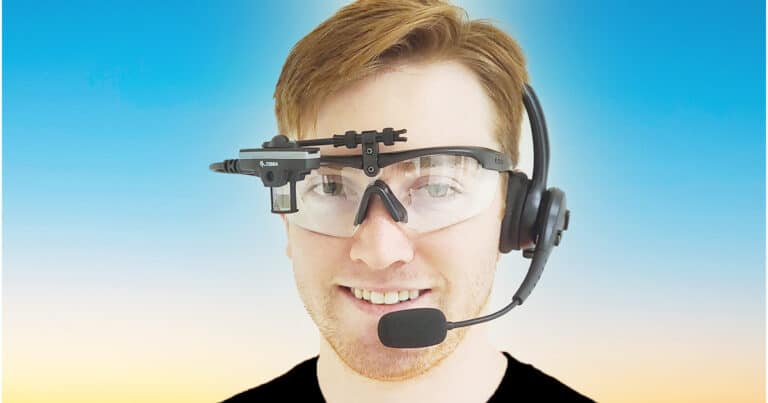
Smart glasses are a description of glasses that incorporate wearable computing technology. There are a variety of smart glasses available today which include technology such as a heads-up display or HUD which displays information in the field of view of the glasses, video capability, light sensitivity, microphones, augmented reality and 3D reality. Smart glasses technology varies according to the purpose of the glasses and the benefits intended for the users.
The Zebra Technologies HD4000 is a rugged enterprise-class head-mounted display which has been designed for industry environments. The HD4000 was developed with Six15 Technologies, the leader in innovation in wearable optical displays. Special attention was given to comfort, rugged design, and ease of use. The HD4000 is feather light yet built to last for years and weather drops, bumps and spills, the crisp, sharp, easy-to-see clear display and the plug-and-go design, with no additional batteries or staging required. The HD4000 works with Zebra mobile computers such as the TC7x, TC5x and the WT6000.
With the ability to integrate visual information for the workforce, true multimodal support is now available for mobile applications. Workers hands and eyes are free to focus on tasks and if integrated with voice technology, voice and visual information can be integrated with scanning and more in the same workflow. New levels of productivity are enabled with true multimodal workflow support.
We hear a lot about automation in the supply chain. It will be some time before a fully automated fulfillment center is available to all organizations, due to cost and functional limitations. However, moving in that direction are technologies that augment the human workforce. Smart Glasses, Heads-Up Display offered by the HD4000 support new levels of workforce productivity. HUD devices integrated with voice and other multimodal input, use multiple forms of communication to ensure workers have the information needed for peak performance.
Yes, HUD devices are safer for the employees since workers hands and eyes are freed, they can be more aware of their surroundings and use more care executing tasks. The Zebra HD4000 works with off-the-shelf safety glasses designed to protect the eyes and the lightweight optical module of the HD4000 can be positioned on the left or right eye location. The optical module can be seen simply by looking up in the field of vision, and if desired can be flipped-up and out of the field of view entirely.
Many DC’s have backend systems and fulfillment operations in place which have been optimized and tailored to their business, products, and fulfillment partners. Continual improvement is ever present with the operational necessity to offer new forms of product delivery, minimize downtime for production operations and minimize operational expenses. While some organizations can embrace a wholesale change to their operations, many companies are weighing their options more carefully, especially in the current environment. When looking at the investment and risk associated with some of the changes that operations professionals could implement, improving existing processes with minimal operational interruption – while gaining measurable benefits quickly and with a short ROI period, that’s a strong value proposition that resonates with our customers. What can we do now, for a reasonable investment that will demonstrate operational benefits – without major risk to the firm? Automating the workforce to be more efficient – automating the individual that is executing the process, empowering them.
Vision with voice is especially compelling for reducing the ramp-up time for new staff and seasonal team members. If the entire standard operating procedure takes a couple of weeks to learn without voice and vision automation, with voice and vision guiding the worker, a few weeks can shrink to a few days. This has significant implications for workforce management. Multimodal directed work automates the training process. That is a huge win for many organizations.
Vision picking is another technology which has multiple definitions. Some vendors define vision picking as working with smart glasses that incorporate Automated Reality to aid with pick locations. Other vendors incorporate some form of scanning technology onto the smart glasses; however, this approach has been shown to be slow, have limitations regarding distance, user orientation and accuracy. Industrial strength barcode scanning technology from companies such as Zebra Technologies has been proven to be high performance, accurate and versatile, which is recommended for industrial workflows.
With voice and vision working together, AccuSpeechMobile is designed to automate a process. I would prefer to think of it as Voice Automated Vision Picking, but you could refer to what AccuSpeechMobile offers as vision picking as well.
Yes, AccuSpeechMobile is integrated with the Zebra Technologies HD4000. This allows us to automate processes and display content on the smart glasses and simultaneously deliver voice commands and receive voice input. Workers have multiple inputs for information and there is no need to even repeat information as it can be presented on the HUD. Hands are free to move items or focus on inspection or repair and eyes are freed from looking at a device. It is like the worker’s own personal guidance through the task.
If you are already using barcode scanners, AccuSpeechMobile can be used to voice automate the workflow. The barcode scanning is simply part of the automated workflow. Text-to-speech and speech-to-text can be incorporated with automation sequences on the device to remove unnecessary steps and simplify the process, text and image information can be presented on the smart glasses. Additional levels of productivity and accuracy will be realized from adding voice and vision automation to the process.
Using voice automated multimodal vision and scanning to improve processes automates task information and confirmation, delivers a better work experience, reduces ramp-up for new employees, eases workforce management by reducing training for new team members, while improving safety by freeing users hands and eyes for other tasks.
Perhaps most importantly, adding voice & vision multimodal workflow automation allows organizations to optimize existing systems and processes, without disrupting production operations. Adding multimodal directed workflows is an exciting option for industry operations professionals.